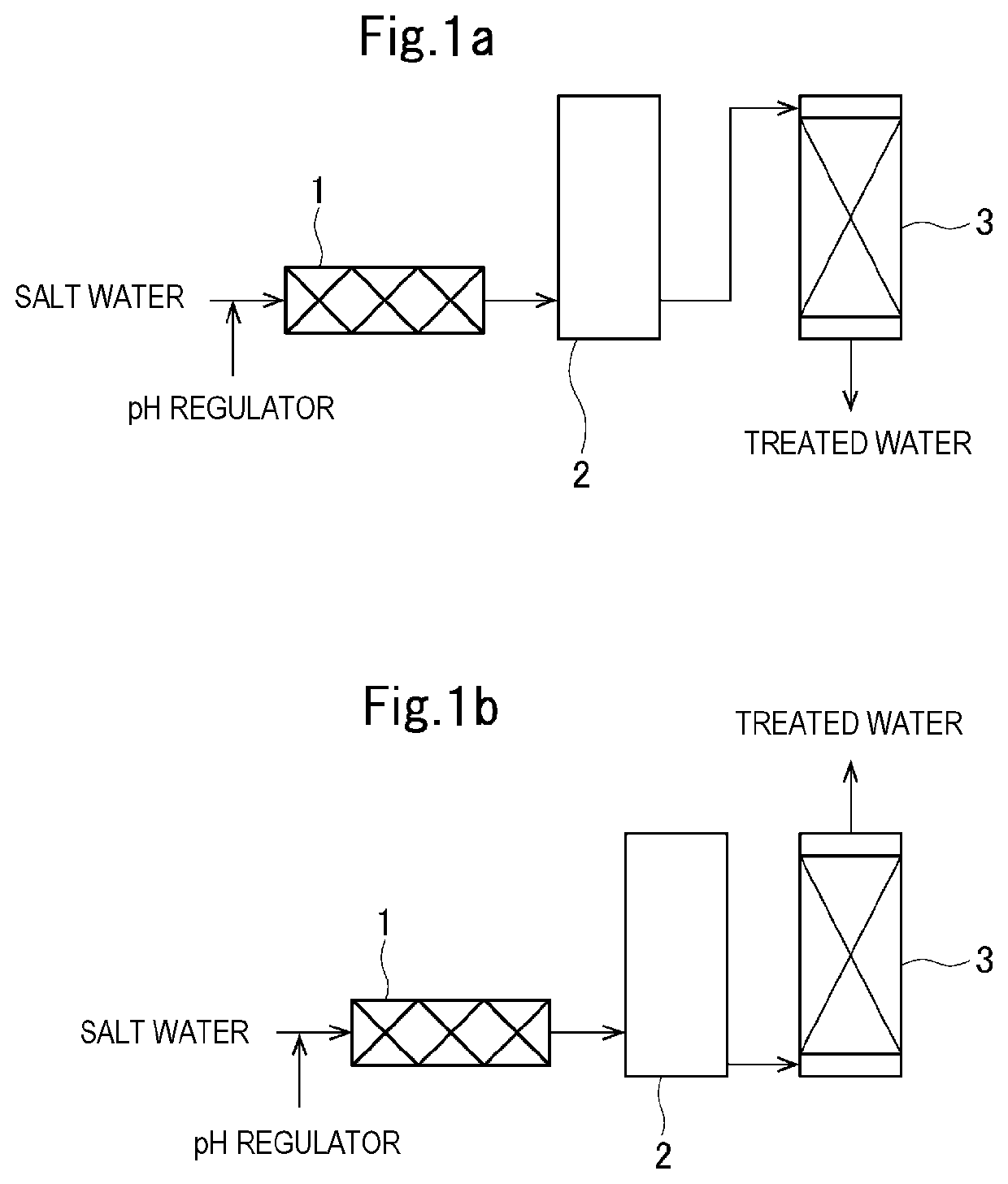Method for removing silica in salt water
a technology of salt water and silica, which is applied in the direction of water/sewage treatment by ion exchange, water treatment parameter control, ion exchanger, etc., can solve the problems of increasing electric resistance, reducing the durability of electrodes or ion exchange membranes, and reducing the electrolytic efficiency by inhibiting ion transfer, so as to achieve stable production and reduce the electrolytic efficiency or durability
- Summary
- Abstract
- Description
- Claims
- Application Information
AI Technical Summary
Benefits of technology
Problems solved by technology
Method used
Image
Examples
example 1
[0041]Raw water was prepared by adjusting salt water having a sodium chloride concentration of 26% by weight and a silica ion concentration of 3 mg / L in which natural rock salt was dissolved to a pH of 10.5 with sodium carbonate. This raw water was flowed in an upward flow at a linear flow rate (LV) of 0.5 m / h at room temperature (20° C.) in a column filled with 20 mL of a commercially available hydrous cerium hydroxide adsorbent “READ-B” (registered trademark of Nihonkaisui Co., Ltd.) as an adsorbent containing a metal hydroxide.
[0042]The hydrous cerium hydroxide adsorbent “READ-B” is a product prepared by dispersing hydrous cerium hydroxide powder in a solution of a copolymer resin of vinylidene fluoride and propylene hexafluoride and then granulating while distilling off the solvent. The amount of cerium hydroxide in the adsorbent is equivalent to 400 parts by weight of cerium hydroxide per 100 parts by weight of resin.
[0043]The silica ion concentration of the obtained treated wa...
example 2
[0045]The same raw water as in Example 1 was flowed in an upward flow at a linear flow rate (LV) of 0.5 m / h at room temperature (20° C.) in a column filled with 5 mL of an anion exchanger having a glucamine group (chelate resin “Diaion (registered trademark) CRB05” manufactured by Mitsubishi Chemical Corporation). The silica ion concentration and the salt concentration of the obtained treated water were determined in the same manner as in Example 1. The sodium chloride concentration in the treated water was 26% by weight, the silica ion concentration was 0.8 mg / L, and it was confirmed that the silica ions had been adsorbed and removed by an ion exchange action without the sodium chloride in the salt water being adsorbed and removed.
example 3
[0046]The same raw water as in Example 1 was flowed in a downward flow at a linear flow rate (LV) of 0.5 m / h at room temperature (20° C.) in a column filled with 20 mL of the same hydroxide-containing adsorbent “READ-B” as in Example 1. The silica ion concentration and the salt concentration of the obtained treated water were determined in the same manner as in Example 1. The sodium chloride concentration in the treated water was 26% by weight, the silica ion concentration was less than 0.2 mg / L, and it was confirmed that the silica ions had been adsorbed and removed by an ion exchange action without the sodium chloride in the salt water being adsorbed and removed.
PUM
| Property | Measurement | Unit |
|---|---|---|
| pH | aaaaa | aaaaa |
| pH | aaaaa | aaaaa |
| concentration | aaaaa | aaaaa |
Abstract
Description
Claims
Application Information
 Login to View More
Login to View More - R&D
- Intellectual Property
- Life Sciences
- Materials
- Tech Scout
- Unparalleled Data Quality
- Higher Quality Content
- 60% Fewer Hallucinations
Browse by: Latest US Patents, China's latest patents, Technical Efficacy Thesaurus, Application Domain, Technology Topic, Popular Technical Reports.
© 2025 PatSnap. All rights reserved.Legal|Privacy policy|Modern Slavery Act Transparency Statement|Sitemap|About US| Contact US: help@patsnap.com

